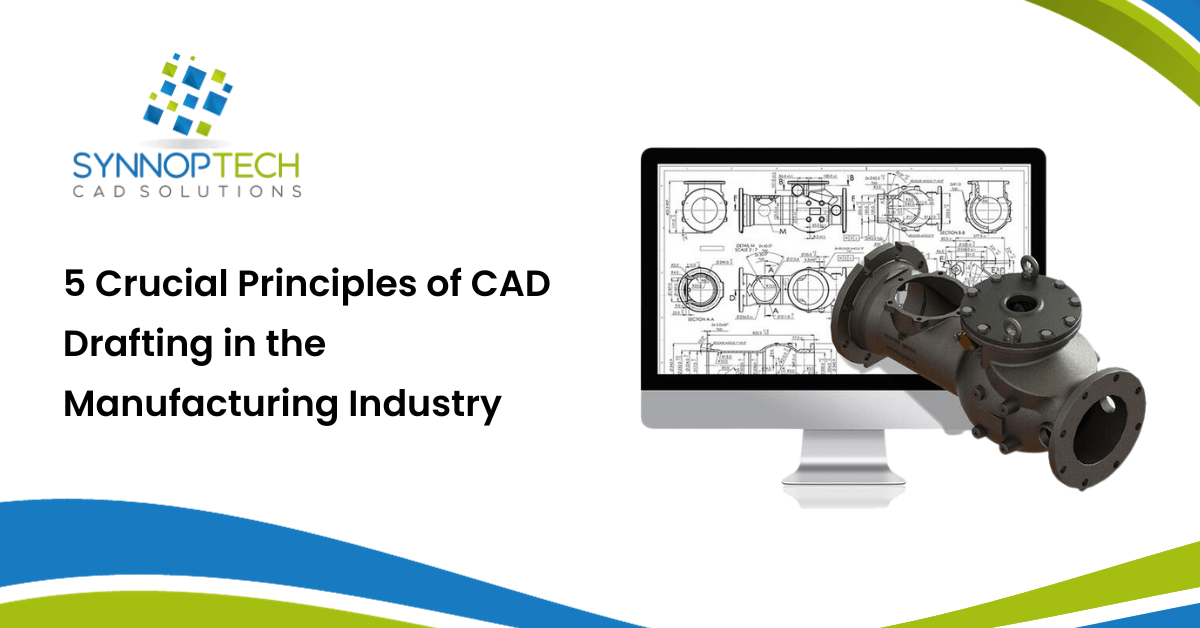Design for Manufacturing includes the process of making designs for goods, parts, or components that are simple to produce with the aim of manufacturing them more affordably. This is accomplished by streamlining, improving, and perfecting the product design. Often DFM and the abbreviation DFMA (Design for Manufacturing and Assembly) are used interchangeably. In this blog we’ll discuss about five crucial principles of CAD Drafting for the manufacturing industry
The following are the five principles of design for manufacturing:
- Process
- Design
- Material
- Environment
- Compliance/ Testing
DFM takes place early in the design process. All parties involved in the project, including engineers, designers, contract manufacturers, mould builders, and material suppliers, must be included in a successfully completed DFM. Its “cross-functional” DFM’s goal is to challenge the design and examine it from all angles, including the component, sub-system, system, and holistic levels, to make sure it is cost-effective and optimal.
Changes grow more expensive as the design moves through the product life cycle and are also more challenging to accomplish. Early DFM enables quick and inexpensive site execution of design changes.
What to consider when making a design for production?
Examine each component of your design.
- Examine the original sketches.
- Take the product apart.
- Examine rival and adjacent items as well as market leaders like the medical and automobile industries.
- Speak with your contract manufacturer; they might have found a solution working with another client.
- Has this issue been resolved differently by someone else?
- Is there a way to improve it?
Also Read: Top 3 Ways 3D CAD Drawings Improve Product Development
5 Principles of Designs in the Manufacturing Industry:
PROCESS:
The manufacturing method must be appropriate for the component or end product. You wouldn’t want to use an expensive process, such as injection moulding, which necessitates the creation of tools and dies, to produce a small number of parts that might have been produced more affordably.
Consider the number of pieces being manufactured, the material being used, the intricacy of the surfaces, the needed tolerances, and whether any additional procedures were necessary while choosing the manufacturing method.
DESIGN:
Design is important. The part or product’s actual drawing needs to follow acceptable manufacturing practises for the manufacturing technique you’ve selected.
Talk about the design with your contract manufacturer so they can make sure it complies with acceptable manufacturing practises for the chosen technique.
MATERIAL:
Choosing the right material for your part or product is crucial.
- Some material characteristics to take into account during DFM are:
- Durability of the material.
- Does the material have reflecting or transparent optical properties?
- Heat resistant of the material.
- Color of each component to be produced
- Electrical properties: Does the substance need to be dielectric—that is, an insulator rather than a conductor—in order to function?
- What level of flame/burn resistance is required for the material?
Once more, make sure to talk about the material with your contract manufacturer. They might have access to materials that are already in their portfolio and be able to help you negotiate a reduced material price.
ENVIRONMENT:
Your component/product must be built to survive the environment to which it will be exposed. No amount of form will matter if the component cannot operate correctly under normal operating circumstances.
COMPLIANCE AND TESTING:
Standards for product safety and quality must be met by all goods. These standards can be third-party standards, internal standards set by the company, or standards set by the industry.
The testing facilities used by your manufacturer must be ISO-certified.
Also Read: Point Cloud Conversion to 3D Modeling
Conclusion
A successful DFM should reduce the design’s complexity and meet the customer’s pricing, specification, material, and schedule demands. If you are looking for the best designs while following all these principles, contact SynnopTech CAD Solutions, our technical know-how will be useful for your project.


